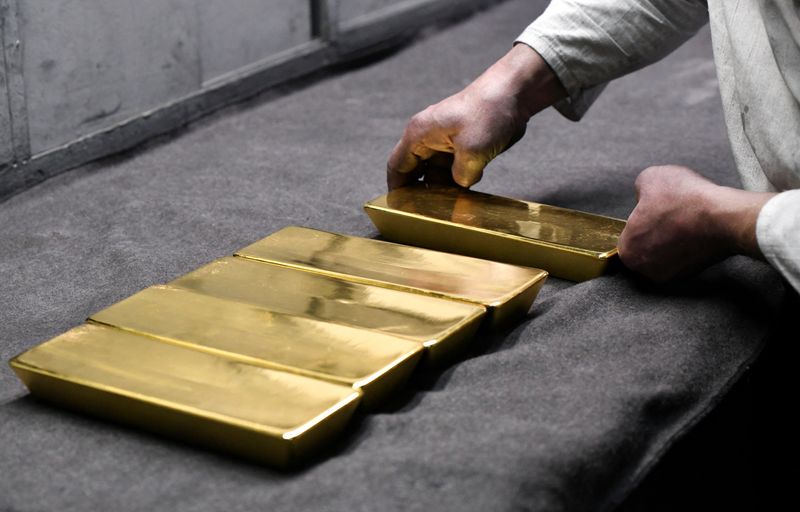Investing.com – Prices soared to record highs, reaching a new high of $2,449.89 per ounce on Monday. also reached its highest level in several years last week, also showing strong increases.
Although all three have currently retreated from these record levels, they remain close, with analysts expecting prices to rise over the next twelve months.
If you’re interested in making strong investment returns in gold that exceed market gains, there’s one tool that can help you do just that: InvestingPRO. InvestingPRO’s exclusive AI-driven data helps you identify the trajectory of gold stocks. Register now with a discount of up to 40% using the discount code SAPRO2 via this link!
What will drive the rise in precious and industrial metals?
While spot gold is currently trading at $2,342, ANZ Bank said in a recent note that gold prices have maintained their upward momentum amid renewed US dollar weakness and falling US government bond yields. But that is not everything.
ANZ analysts wrote: “While geopolitical risks continued to drive demand for safe havens, the astonishing rise in gold demand in China in the first quarter of 2024 has largely contributed to the price rise.”
China is currently the world’s largest consumer of gold and will surpass India as the world’s largest buyer of gold jewelry by 2023.
World Gold Council data shows that Chinese consumers led the way among gold buyers, purchasing 603 tons of gold jewelry last year, up 10% from 2022. The World Gold Council expects demand for Chinese jewelry to be high this year remain, or even higher than in 2023.
Meanwhile, analysts at UBS Bank raised their gold price forecast to $2,500 per ounce by the end of September and $2,600 by the end of the year. The bank’s bullish forecast is attributed to strong Chinese demand, along with a series of weak US data in April that caused a revaluation of expectations for US interest rate cuts.
High interest rates tend to put pressure on gold because they make government bonds – which are also safe havens – a more attractive option for investors.
Johnny Teves, a precious metals strategist at UBS, told CNBC: “We believe gold can continue to reach new all-time highs.”
The poor cousin of gold
Nikos Kavalis, director of precious metals research consultancy Metals Focus, told CNBC: “You could say that silver has been more interesting – and ultimately has had a strong rise, like gold.”
Silver rose to more than $31 an ounce, reaching its highest level in more than a decade last Wednesday, amid growing investor interest and a shortage of the precious metal. It is currently trading at $31.31 per ounce.
Teves said: “We believe silver is actually the best precious metal to really benefit from gold price increases.” He emphasized that there is a very strong relationship between the two.
He added that when the Federal Reserve cuts rates, silver is “well positioned to really outperform gold,” especially with the metal shortage.
Daniel Hynes, senior commodities strategist at ANZ Bank, said: “Slowing mining output growth and strong industrial demand indicate supply is below demand, leaving the market in structural deficit.”
Silver is widely used for industrial purposes and is often processed in the automotive, solar panel, jewelry and electronics industries.
Metals Focus’ Kavalis said other precious metals such as platinum, palladium and rhodium are also experiencing shortages this year, and therefore we may see significant price increases.
Copper shines
Copper prices have also risen sharply recently, hitting a record high of $10,857 per tonne last Tuesday before retreating.
ANZ Bank said copper prices were “well supported by supply shortages” this year amid increasing supply constraints.
Last November, First Quantum Minerals (OTC:) halted production at the Cobre Panama copper mine, one of the largest copper mines in the world, following a Supreme Court ruling and nationwide protests over environmental issues. Anglo American (JO:), a major producer, said it would cut copper production in 2024 and 2025 as part of its efforts to reduce costs.
Citigroup strategists said in a note earlier this month that they expect copper prices to rise over the next three to six months, but they believe copper still has room to rise further depending on the extent of U.S. interest rate cuts and the recovery of global production.
Citigroup strategists said: “We remain confident that copper is heading towards $12,000 per tonne, and $15,000 per tonne in our bullish forecast for the next twelve to eighteen months.”


